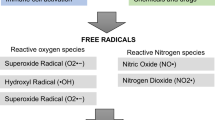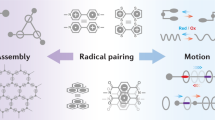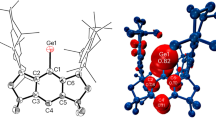Abstract
FREE radicals responsible for the propagation of chain reactions are commonly formed by the photochemical or thermal decomposition of an appropriate labile substance, and are, in such cases, inevitably produced in pairs. The restricted mobilities of radicals in solution have some special influence on the fate of these radicals, in that many pairs of radicals recom-bine before bringing about any reaction1. This effect, sometimes known as the cage effect but more recently called2 geminate recombination has been widely discussed. A further consequence of the production of radicals in pairs has not, however, received consideration Even if a free radical avoids recombination with its twin radical in the primary cage, the chain carrier will in general, at least in the earlier part of its life, lie closer to its twin than to another chain carrier. There is therefore a finite and sometimes appreciable probability of the mutual termination of geminate chains. The proportion of mutual termination of geminate chains must depend, on one hand, on factors controlling the rate of diffusion of the radicals in the medium and, on the other, the average relative distances of a radical to its twin and other radicals, and this will depend on the rate of decomposition of the initiating molecule.
This is a preview of subscription content, access via your institution
Access options
Subscribe to this journal
Receive 51 print issues and online access
$199.00 per year
only $3.90 per issue
Buy this article
- Purchase on SpringerLink
- Instant access to full article PDF
Prices may be subject to local taxes which are calculated during checkout
Similar content being viewed by others
References
Rabinowitch, E., Trans. Farad. Soc., 33, 1225 (1935).
Noyes, R. M., J. Amer. Chem. Soc., 77, 2042 (1955).
Walling, C., Free Radicals in Solution (Wiley, New York 1958).
Bengough, W. I., and Melville, H. W., Proc. Roy. Soc., A, 230, 429 (1955).
Hayden, P., and Melville, Sir Harry, J. Polymer Sci., 43, 201 (1960).
Allen, P. W., Merrett, F. W., and Scanlan, J., Trans. Farad. Soc., 51, 95 (1955).
Burnett, G. M., and Loan, L. D., Coll. Czech. Chem. Comm., 22, 113 (1957).
Bamford, C. H., Jenkins, A. D., Ingram, D. J. E., and Symons, M. C. R., Nature, 175, 894 (1955).
Atherton, N. M., Melville, H. W., and Whiffen, D. H., J. Polymer sci., 34, 199 (1959).
Author information
Authors and Affiliations
Rights and permissions
About this article
Cite this article
ALLEN, P., PATRICK, C. Generation of Radicals in Pairs and the Kinetics of Radical Chain Reactions in Solution. Nature 191, 1194–1195 (1961). https://doi.org/10.1038/1911194b0
Issue date:
DOI: https://doi.org/10.1038/1911194b0



